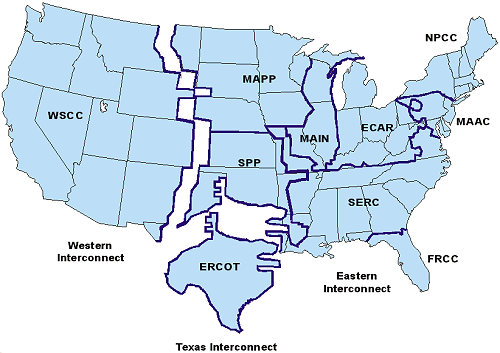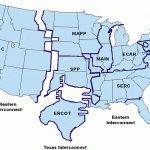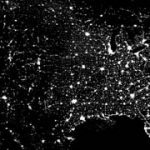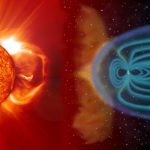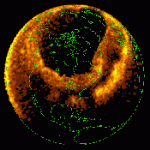The US power grid is a complex electrical apparatus that has well-known sensitivities to space weather disturbances. Recent changes in its design and utilization have significantly reduced its operating margins to supply us with on-demand electricity. This means there is less flexibility available with which to deal with power shortages and blackouts.
Space weather events can damage equipment over wide geographic regions so that recovery delays become substantially longer and more costly.
The 23rd Cycle – Chapter 4 – Describes in detail the state of the US power grid, and the forces which are driving it to be far more vulnerable to solar storms than at any time in the past.
“As North America has evolved into a unified power-sharing network of regions, each buying and selling a diminishing asset, US domestic power has become more vulnerable to solar storms buffeting the power grid in the more fragile northern-tier states and Canada. So long as one region continues to have a surplus at a time when another region needs a hundred megawatts, power is ‘wheeled’ through 1000-mile power lines to keep supply and demand balanced across the grid. In 1972, a typical utility might need to conduct only a few of these electromagnetic transactions each week. Now, it is common for thousands to be carried out, often by computer, in much the same way that stocks are traded on Wall Street…
The electrical power grid is composed of many elements, and you can think of it as a set of rivers flowing overhead. Large rivers carry the electricity from distant generation stations (Dams, Hydroelectric Facilities and Nuclear Plants) on supply lines of 138,000 volts or higher. These are carried as three cables (2 ‘hot’ and one defining the ‘ground’ in a 3-phase system) suspended atop 100-foot tall towers that you will see out in many rural areas. These supply cables terminate at regional substations where the high voltages are converted into lower voltages from 69,000 volts to 13,800 volts. These lines then enter your neighborhoods atop your local telephone poles where a neighborhood transformer steps this voltage down to 220 and supplies a dozen or so individual houses.
When space weather disturbances cause ‘Geomagnetically Induced Currents’ , these GICs can enter a transformer through its Earth ground connection. The added DC current to the transformer causes the relationship between the AC voltage and current to change at the source of the electricity, not just where it is delivered to your electrical appliance. Because of the way that GIC currents affect the transformer, it only takes a hundred amperes of GIC current or less to cause a transformer to overload during one-half of its 60-cycle operation. As the transformer switches 60 times a second between being saturated and unsaturated, the normal hum of a transformer becomes a raucous, crackling whine. Regions of opposed magnetism as big as your fist in the core steel plates crash about and vibrate the 100-ton transformer nearly as big as a house in a process that physicists call magnetostriction.
The impact that magnetostriction has upon specific transformers is that it generates hot spots inside the transformer where temperatures can increase very rapidly to hundreds of degrees in only a few minutes. Temperature spikes like these can persist for the duration of the magnetic storm which, itself, can last for hours at a time. During the March 1989 storm, a transformer at a nuclear plant in New Jersey was damaged beyond repair as its insulation gave way after years of cumulative GIC damage. Allegheny Power happened to be monitoring a transformer that they knew to be flaky. When the next geomagnetic storm hit in 1992. They saw the transformer reply in minutes, and send temperatures in part of its tank to more than 340 F (171 C). Other transformers have spiked fevers as high as 750 F (400 C). Insulation damage is a cumulative process over the course of many GICs, and it is easy to see how cumulative solar storm and geomagnetic effects were overlooked in the past.
Outright transformer failures are much more frequent in geographic regions where GICs are common. The Northeastern US with the highest rate of detected geomagnetic activity led the pack with 60% more failures. Not only that, but the average working lifetimes of transformers is also shorter in regions with greater geomagnetic storm activity. The rise and fall of these transformer failures even follows a solar activity pattern of roughly 11 years.
If your power plant is located over a rock stratum with low resistance, any geomagnetic disturbance will cause a bigger change in the voltages it induces in your local ground, and the bigger this change in ground voltage, the stronger will be the GIC currents that flow into your transformers. Typical daily GICs can run at about 5-10 amperes, but severe geomagnetic storms can cause 100-200 amperes to flow.
A conservative estimate of the damage done by GICs to transformers by Minnesota Power and Electric was $100 million during a solar-maximum period. This includes the replacement of damaged transformers, and the impact of shortened operating lifetimes due to GIC activity.
Large transformers cost $10 million, and can require a year or more to replace if spares are not available. During a transformer failure, an affected utility company will have to purchase replacement power from other utilities for as much as $400,000 per day or more. Oak Ridge National Laboratories, meanwhile, estimated that a solar storm event only slightly stronger than the one that caused the Quebec blackout in 1989 would have involved the Northeast United States in a cascading blackout. The experts figured that about $6 billion in damages and lost wages would have resulted from such a widespread involvement. The North American Electric Reliability Council (NAERC) placed the March 1989 and October 1991 storm events in a category equivalent to Hurricane Hugo or the 1989 Loma Prieta Earthquake in San Francisco. But, many consultants for the power industry dispute NAERC’s estimate saying that it is much too low. The $6 billion may not properly include collateral impacts such as lost wages and productivity, spoiled food and a myriad of other human costs that could easily run the losses into the tens of billions of dollars.”
Congressional Testimony – On October 30, 2003 the House of Representatives, Subcommittee on Environment, Technology and Standards convened a session ‘What is Space Weather and who should forecast it?’. The following is an excerpt of the testimony by John Kappenman, Manager, Applied Power Systems, Metatech Corporation:
” While electricity customers receive power from the local distribution system (typical operating voltage of 15kV with step down to 120/240 volt), the backbone of the system is the high voltage transmission network. The primary AC transmission network voltages in the U.S. are at 230kV, 345kV, 500kV and 765kV. These transmission lines and their associated transformers serve as the long distance heavy hauling arteries of electricity production in the U.S. A single 765kV transmission line can carry over 2000 MW of power, nearly 200 times what a typical 15kV distribution line which is the overhead line commonly used for residential distribution. Space Weather or geomagnetic disturbances directly attack this same high voltage transmission circulatory system and because both have continental footprints, these disturbances can rapidly erode reliability of these infrastructures and can therefore threaten widespread blackout for extreme disturbance events. The U.S. electric power grid is the world’s most extensive, Figure 1 provides a map of the approximate location of the nearly 80,000 miles of 345kV, 500kV and 765kV transmission lines in the contiguous U.S….
In spite of the best efforts, failures still can occur; for example, a lighting strike can still cause on occasion a high voltage transmission line to trip. Very high winds, for example, due to a tornado can cause the failure of a line or several lines on a common corridor. However, most of these events generally occur in isolation and power grids are operated at all times to withstand the largest creditable single contingency failure without causing a cascading collapse of the network itself. Space Weather differs from ordinary weather in that it has a big footprint and attacks the system across many points simultaneously, causing at times of severe events multi-point failures on the network that can threaten the integrity of the network. Therefore, geomagnetic storms may be one of the most important hazards and is certainly the least understood threat that could be posed to the reliable operation of these networks…
There were several noteworthy cases of transformer internal heating associated with the March 13, 1989 storm in the U.S. mid- Atlantic Region. In one case at the Salem Nuclear plant in southern New Jersey, the internal heating was so severe that complete failure of the transformer resulted. Figure 7 provides a few pictures of the transformer and internal winding damage (conductor melting and insulation burns) due to the GIC exposure. In this case the entire nuclear plant was unable to operate until the large 500kV 1200MVA transformer was replaced. Fortunately a spare from a canceled nuclear plant in Washington State was available and restoration of the plant occurred in 40 days. Transformers of this type are of custom design and in most cases new replacement transformers of this type generally take up to a year for delivery. Failures of key apparatus, such as this, raise concerns about the ability to rapidly restore power in a region once a blackout and failure has occurred…
We are looking at the potential of blackouts that could exceed even that of the very large blackout that occurred just a few months ago [August 14, 2003]. And there is no part of the U.S. power grid that is immune to this. It is just a matter of where does this intense phenomenon geographically lay down? How big is the footprint? And we know these footprints can be very, very large. And literally, we could impact over 100 million population in the worst case scenarios.”
2002-Department of Energy – National Transmission Grid Study “Over the past 10 years, competition has been introduced into wholesale electricity markets with the goal of reducing costs to consumers. Today, wholesale electricity sales save consumers nearly $13 billion annually. However, the Nations outdated transmission system was not designed to support todays regional, competitive electricity markets. Investment in the transmission system has not kept pace with the growth in generation and the increasing demand for electricity. Transmission bottlenecks threaten reliability and cost consumers hundreds of millions of dollars each year. ”
The Changing Structure of the Electrical Power Power Grid ca 2000 – This study by the Department of Energy describes the impact that deregulation will have on the operation of the Grid.
National Security Telecommunications Advisory Committee – Provides a detailed assessment of the many risks that our power grid faces. “The Electric Power Risk Assessment” subgroup found no evidence of power outages attributed to deliberate electronic intrusion into utility control systems. The greatest risk facing the electric power infrastructure of the United States remains physical damage and destruction. Compared to the threat posed by natural disasters and physical attacks on electric power infrastructure elements, electronic intrusion represents an emerging, but still relatively minor, threat. However, changes within the electric power industry and in technology are increasing the risk posed by electronic intrusion. ”
2004 – Penn State Study of Power Grid Failure – The team’s topological analysis of the grid structure reveals that, although the system has been designed to withstand the random loss of generators or substations, its integrity may depend on protecting a few key elements.
“Our analysis indicates that major disruption can result from loss of as few as two percent of the grid’s substations,” says Albert, whose research team includes Istvan Albert, research associate in the Bioinformatics Consulting Center at Penn State, and Gary L. Nakarado at the National Renewable Energy Laboratory.
One implication of the research is that identification of strategic points in the grid system can enhance defense against interruptions, whether by equipment failure, natural disasters or human activity. Major blackouts caused by failures in the grid, such as the one that affected the northeastern part of the country during the summer of 2003, incur tremendous economic, public-health and security risks.
The study, titled “Structural Vulnerability of the North American Power Grid,” was published in a recent issue of the journal Physical Review E. The researchers constructed a model of the entire transmission grid with over 14,000 “nodes,” including generators, transmission substations, and distribution substations, and over 19,000 “edges,” corresponding to the high-voltage transmission lines that carry power between the nodes. They measured the importance of each substation node based on its “load,” or the number of shortest paths between other nodes that pass through it.
More From SolarStorms.org:
Submit your review | |

